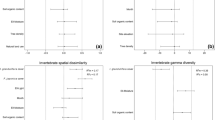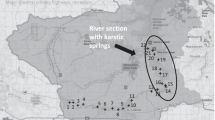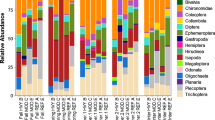Abstract
Invasive alien trees along river banks can reduce indigenous biodiversity, while their removal can restore it. We assessed here family- and species-level responses of river benthic macroinvertebrate assemblages to three riparian vegetation types (natural, alien trees, cleared of alien trees) in the Cape Floristic Region biodiversity hotspot. High species beta diversity of this highly endemic fauna meant that between-river, as well as seasonal effects, dominated assemblage patterns. SASS5, a qualitative, rapid bioassessment technique, based on the sensitivity of the families present, was used as a measure of river health and, indirectly, of water quality. SASS indicated a decline in water quality conditions after alien clearing, a likely response to the greater insolation and apparent erosion of cleared banks, resulting in elevated temperatures and suspended solids and lowered oxygen levels. Overall, cleared and natural sites were more similar to each other than to alien sites, suggesting some post-clearing recovery. However, many sensitive, endemic taxa survived in alien-invaded sites, and more than in the natural sites. These endemic species made use of shady, cool, high-oxygen levels under the alien tree canopy. However, endemics declined in overall abundance in sites cleared of aliens, being replaced by more tolerant, widespread taxa. Clearance of the alien trees opened up the rivers to sunny conditions, which had a major impact on community composition. Vegetation types, oxygen levels and river width were important environmental variables affecting these macroinvertebrate responses. Re-establishment of invertebrate biodiversity matched that of indigenous vegetation, with the most sensitive endemic taxa only recovering after establishment of bushy indigenous and shade-producing fynbos. Therefore, for biodiversity conservation objectives to be achieved, it is essential that indigenous plants are maintained and encouraged during and after clearing to ensure the recovery of endemic and sensitive taxa.



Similar content being viewed by others
References
Allan JD, Flecker AS (1993) Biodiversity conservation in running waters. BioScience 43:32–43
Barber-James HM, Lugo-Oritz CR (2003) Ephemeroptera. In: de Moor IJ, Day, de Moor FC (eds) Freshwater invertebrates of Southern Africa, vol 7: Insecta I; Ephemeroptera, Odonata and Plecoptera. WRC report no. TT 207/03. Water Research Commission, Pretoria, pp 16–142
Bunn SE, Boon PI (1993) What sources of organic carbon drive food webs in billabongs? A study based on stable isotope analysis. Oecologia 96:85–94
Bunn SE, Davies PM, Mosisch TD (1999) Ecosystem measures of river health and their response to riparian and catchment degradation. Freshw Biol 41:333–345
Campbell IC, Doeg TJ (1989) Impact of timber harvesting and production on streams. Aust J Mar Fresh Res 40:519–539
Chessman BC (1995) Rapid assessment of rivers using macroinvertebrates: a procedure based on habitat-specific sampling, family level identification and a biotic index. Aust J Ecol 20:122–129
Chutter FM (1972) An empirical biotic index of the quality of water in South African streams and rivers. Water Res 6:19–30
Clarke KR, Warwick RM (2001) Change in marine communities: an approach to statistical analysis and interpretation, 2nd edn. PRIMER-E Ltd, Plymouth
Cummins KW, Wilzbach MW, Gates DM, Perry JB, Taliaferro WB (1989) Shredders and riparian vegetations. BioScience 39:24–30
Dallas HF, Day DE (1993) The effect of water quality variables on riverine ecosystems: a review. WRC report no. TT 61/93. Water Research Commission, Pretoria
Dallas HF, Day JA (2007) Natural variation in macroinvertebrate assemblages and the development of a biological banding system for interpreting bioassessment data—a preliminary evaluation using data from upland sites in the south-western Cape, South Africa. Hydrobiol 575:231–244
Davies B, Day J (1998) Vanishing waters. University of Cape Town Press, Cape Town
Day JA, King JM (1995) Geographical patterns, and their origins, in the dominance of major ions in South African rivers. S Afr J Sci 91:299–306
Dickens CWS, Graham PM (2002) The South African Scoring System (SASS) version 5 rapid bioassessment system for rivers. Afr J Aquat Sci 27:1–10
Fischer DG, Hart SC, Schweitzer JC, Selmants PC, Whitham TG (2010) Soil nitrogen availability varies with plant genetics across diverse river drainages. Plant Soil. doi:10.1007/s11104-009-0260-2
King JM (1981) The distribution of invertebrate communities in a small South African river. Hydrobiol 83:43–65
King JM (1983) Abundance, biomass and diversity of benthic macro-invertebrates in a Western Cape river, South Africa. Trans R Soc S Afr 45:11–34
King JM, Schael DM (2001) Assessing the ecological relevance of a spatially-nested geomorphological hierarchy for river management. WRC report no. 754/1/01. Water Research Commission, Pretoria
King JM, Scheepers ACT, Fisher RC, Reinecke MK, Smith LB (2003) River rehabilitation: literature review, case studies and emerging principles. WRC report no. 1161/1/03. Water Research Commission, Pretoria
Kinvig RG, Samways MJ (2000) Conserving dragonflies (Odonata) along streams running through commercial forestry. Odonatologica 29:195–208
Lowe SR, Woodford DJ, Impson ND, Day JA (2008) The impact of invasive fish and invasive riparian plants on the invertebrate fauna of the Rondegat River, Cape Floristic Region, South Africa. Afr J Aquat Sci 33:51–62
Maridet L, Philippe M, Wasson JG, Mathieu J (1996) Spatial and temporal distribution of macroinvertebrates and trophic variables within the bed sediment of three streams differing by their morphology and riparian vegetation. Arch Hydrobiol 136:41–64
Maridet L, Wasson JG, Philippe M, Amoros C, Naiman RJ (1998) Trophic structure of three streams with contrasting riparian vegetation and geomorphology. Arch Hydrobiol 144:61–85
Moss D, Furse MT, Wright JF, Armitage PD (1987) The prediction of the macroinvertebrate fauna of unpolluted running-water sites in Great Britain using environmental data. Freshw Biol 17:41–52
Muotka T, Laasonen P (2002) Ecosystem recovery in restored headwater streams: the role of enhanced leaf retention. J Appl Ecol 39:145–156
Myers N, Mittermeier RA, Mittermeier CG, da Fonseca GAB, Kent J (2000) Biodiversity hotspots for conservation priorities. Nature 403:853–858
Ormerod SJ, Wade KR, Gee AS (1987) Macrofloral assemblages in upland Welsh streams in relation to acidity, and their importance to invertebrates. Freshw Biol 18:545–557
Osborn R, Samways MJ (1996) Determinants of adult dragonfly assemblage patterns at new ponds in South Africa. Odonatologica 25:49–58
Quinn JM, Cooper AB, Davies-Colley RJ, Rutherford JC, Williamson RB (1997) Land use effects on habitat, water quality, periphyton and benthic invertebrates in Waikato, New Zealand, hill-country streams. New Zeal J Mar Fresh Res 31:579–597
Richardson DM, van Wilgen BW (2004) Invasive alien plants in South Africa: how well do we understand the ecological impacts? S Afr J Sci 100:45–52
Rosenberg DM, Resh VH (eds) (1993) Freshwater biomonitoring and freshwater macroinvertebrates. Chapman & Hall, New York
Rutherfurd ID, Jerie K, Marsh N (2000) A rehabilitation manual for Australian streams, volumes 1 and 2. Cooperative Research Centre for Catchment Hydrology, and Land and Water Resources Research and development Corporation. Canberra, Australia. Accessible at www.rivers.gov.au
Rutt GP, Weatherley NS, Ormerod SJ (1989) Microhabitat availability in Welsh moorland and forest streams as a determinant of macroinvertebrate distribution. Freshw Biol 22:247–261
Samways MJ (2003) Threats to the tropical island dragonfly fauna (Odonata) of Mayotte, Comoro archipelago. Biodivers Conserv 12:1785–1792
Samways MJ, Sharratt NJ (2010) Recovery of endemic dragonflies after removal of invasive alien trees. Conserv Biol 24:267–277
Samways MJ, Wilmot B (2003) Odonata. In: de Moor IJ, Day JA, de Moor FC (eds) Freshwater invertebrates of Southern Africa volume 7: Insecta I; Ephemeroptera, Odonata and Plecoptera. WRC report no. TT 207/03. Water Research Commission, Pretoria, pp 16–142
Simaika JP, Samways MJ (2009) An easy-to-use index of ecological integrity for prioritizing freshwater sites and assessing habitat quality. Biodivers Conserv 18:1171–1185
Simaika JP, Samways MJ (2010) Comparative assessment of indices of freshwater habitat conditions. Ecol Indic. doi:10.1016/j.ecolind.2010.06.005
Smith J, Samways MJ, Taylor S (2007) Assessing riparian quality using two complementary sets of bioindicators. Biodivers Conserv 16:2695–2713
Steytler NS, Samways MJ (1995) Biotope selection by adult male dragonflies (Odonata) at an artificial lake created for insect conservation in South Africa. Biol Conserv 72:381–386
Suhling F, Sahlén G, Martens A, Marais E, Schutte C (2006) Dragonfly assemblages in arid tropical environments: a case study from western Namibia. Biodivers Conserv 15:311–332
Ter Braak CJF, Ŝmilauer P (2002) CANOCO reference manual and user’s guide to Canoco for windows: software for canonical community ordination (version 4.5). Microcomputer Power, Ithaca
Uys AC (2003) Development of river rehabilitation in Australia: lessons for South Africa. WRC report no. KV 144/03. Water Research Commission, Pretoria
Vuori K, Joensuu I (1996) Impact of forest drainage on the macroinvertebrates of a small boreal headwater stream: do buffer zones protect lotic biodiversity? Biol Conserv 77:87–95
Weatherley NS, Rutt GP, Ormerod SJ (1989) Densities of macroinvertebrates in upland Welsh streams of different acidity and land use. Arch Hydrobiol 115:417–431
Wishart MJ, Day JA (2001) Endemism in the freshwater fauna of the South-Western Cape, South Africa. Verh Internat Verein Theor Angew Limnol 28:1762–1766
Wishart MJ, Davies BR, Stewart BA, Hughes JM (2003) Examining catchments as functional units for the conservation of Riverine Biota and maintenance of biodiversity. WRC report no. 975/1/02. Water Research Commission, Pretoria, South Africa
Wright JF, Moss D, Armitage PD, Furse MT (1984) A preliminary classification of running-water sites in Great Britain based on macro-invertebrate species and the prediction of community type using environmental data. Freshw Biol 14:221–256
Zavaleta ES, Hobbs RJ, Mooney HA (2001) Viewing invasive species removal in a whole-ecosystem context. Trends Ecol Evol 16:454–459
Acknowledgments
This work was supported by the South African Working for Water Programme and the RUBICODE Coordination Action Project (Rationalising Biodiversity Conservation in Dynamic Ecosystems) funded under the Sixth Framework Programme of the European Commission (contract no. 036890), and by a Natural Sciences and Engineering Research Council of Canada (NSERC) PGS-D3 scholarship to John Simaika. We thank the anonymous referees for helpful and constructive comment which improved the manuscript.
Author information
Authors and Affiliations
Corresponding author
Rights and permissions
About this article
Cite this article
Samways, M.J., Sharratt, N.J. & Simaika, J.P. Effect of alien riparian vegetation and its removal on a highly endemic river macroinvertebrate community. Biol Invasions 13, 1305–1324 (2011). https://doi.org/10.1007/s10530-010-9891-8
Received:
Accepted:
Published:
Issue Date:
DOI: https://doi.org/10.1007/s10530-010-9891-8




